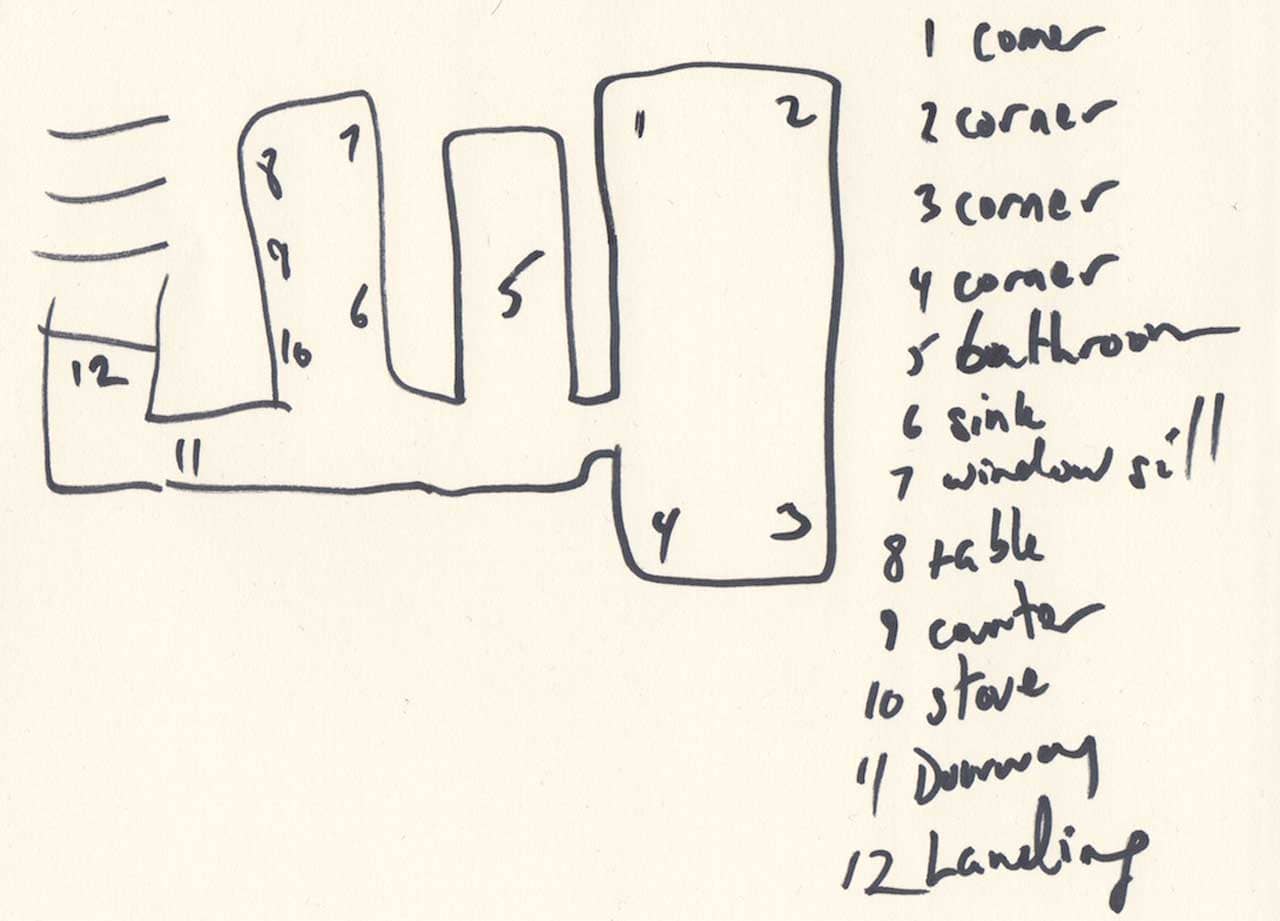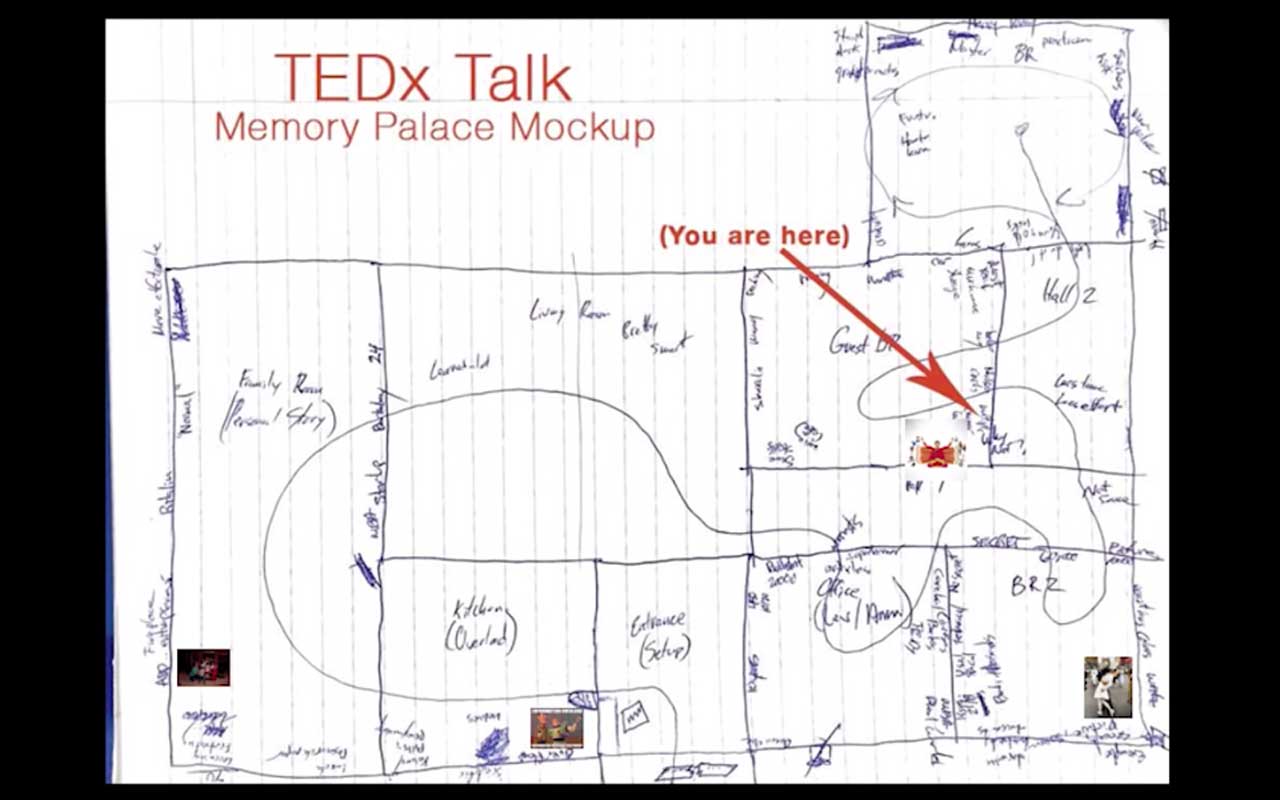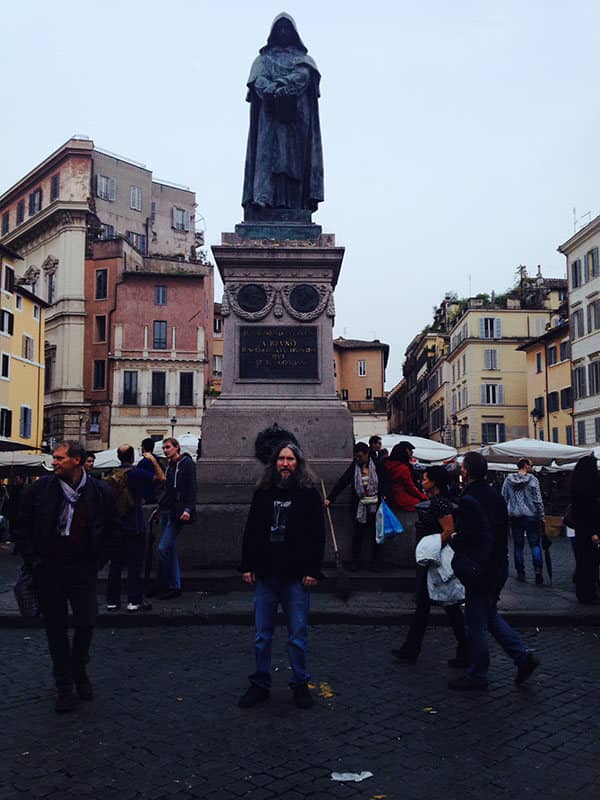Podcast: Download
Subscribe: Apple Podcasts | RSS

You’re in the right place.
I’ve used Memory Palaces to pass exams, master foreign languages to the point of lecturing in German while living abroad.
And my TEDx Talk wasn’t just delivered from memory.
Thanks to the power of the Memory Palace when it comes to presenting well, it has garnered millions of views.
Across all of these experiences, I’ve developed and tested over three hundred Memory Palaces for different learning goals.
Everything from academic outcomes to speaking from the stage and even applying them to the writing of novels.
On this page, I’ll give you 5 powerful Mind Palace examples you can use to improve your memory training practice.
Ready?
Let’s dive in.
Before we get started with the examples, let’s properly define the Memory Palace technique.
This step is important so that we’re on the same page.
Real Memory Palace Examples You Can Copy or Adapt Today
Definitions are important because sometimes people use different words for the same technique.
For example, the Memory Palace technique is sometimes called the Method of Loci. Other people call it the Roman Room technique.
No matter what you call, the technique is based on layering associations along a journey based on locations you remember.
That’s the key.
You’re not memorizing locations for use as Memory Palace. You’re harnessing memory spaces that are already in your memory.
For more details, please refer to my foundational Memory Palace tutorial which goes in-depth on its history and a number of important considerations for getting the most out of the technique.
With these principles in mind, let’s look at our first example.
1. The Bird’s-eye/3rd Person Memory Palace Based On Your Home
This kind of Memory Palace involves looking down through the roof on a building, typically your home.
The basic idea is to experience the Memory Palace as if you’re looking down at a floor plan.
To create your first Memory Palace in this style, I suggest you quickly sketch them out.
As you can see, I’ve drawn this Memory Palace by hand:
Drawing each Memory Palaces is important because it trains your brain to think about the journey through the building you’re assigning.
A bit of preparation in the beginning will ensure that you can use the Memory Palace much faster once you’re ready to use it to memorize anything, including vocabulary, or an entire speech.
I’m not the only one who draws Memory Palaces.
My friend and fellow memory expert Jonathan Levi did just that after I showed him how to do so for his TEDx presentation:
In sum, the process is simple:
- Select a location suited to creating a Memory Palace (usually a familiar building, but parks and other locations will do)
- Get out a sheet of paper, ideally in a Memory Journal devoted to Mind Palace creation.
- Draw the Memory Palace.
- Strategically structure your course through the Memory Palace.
- Practice it mentally.
- Use it to memorize something by drawing upon the tools of Magnetic Association
If you’re stuck on what locations to use, How to Find Memory Palaces will help.
If you need help with creating the imagery, these elaborative encoding exercises should be useful to you.
The cool thing about that TEDx picture above is that I’ve already used the process I just described to turn the theatre into a Mind Palace. And it works great!
2. The Campus Memory Palace
In this kind of Memory Palace, you use an entire university campus.
I found this kind very useful when studying for my PhD at York in Toronto, Ontario, Canada.
For your benefit, I’ve used the campus map to craft this detailed video tutorial for you of this kind of Memory Palace and its many uses:
In this case, you can use the Memory Palace from the top-down view.
Or you can imagine watching yourself walking from station to station. It’s entirely up to you.
Another option is to use the next kind of Memory Palace.
3. The 1st Person Memory Palace
When using a first person approach, here’s what happens:
You imagine yourself in the Memory Palace, literally seeing the journey as if through your own eyes.
Or, you can pretend to be a character in a video game or movie and see through the eyes of that character.
For example, using an outdoor Memory Palace, I once imagined being this Giordano Bruno statue and navigated parts of Rome that I had previously developed into a small set of Memory Palaces.
Personally, I find this approach draining. But it definitely works.
4. The Virtual Memory Palace
Virtual or Imaginary Memory Palaces are not based on real locations.
They are purely imagined or based on video game locations.
This approach is not for everyone however.
I personally find them difficult for my projects, one reason I prefer standard Memory Palace for activities like language learning.
But if you want to give imaginary Memory Palaces a try, I suggest listening to memory competitor Idriz Zogaj for some wisdom on the practice that you might find useful.
In the meantime, I’ve recorded all my best suggestions for the virtual Memory Palace approach in this detailed video tutorial:
5. The Magnetic Memory Memory Method Palace
This kind of Memory Palace combines a number or mnemonic systems.
At its core, you still take a location you know well and mentally assign specific pieces of information.
But unlike other approaches, you develop well-formed Memory Palaces that do not lead you into dead ends or waste time and mental energy by crossing your own path.
An illustrator helped me visualize my TEDx Talk Memory Palace with this picture so you can see how direct and unfettered a Magnetic Memory Palace is:
What additionally sets the Magnetic Memory Palace apart are additional tools that I teach. Such as:
- Sea shelling
- The Pillar Technique
- Ample use of Magnetic Bridging Figures
- Recall Rehearsal
- The Big 5 of Learning (Also called the levels of processing)
- The Story Method
With these additional techniques, everything gets much easier. That’s because my approach also helps make the technique more fun.
It feels like a game as you usher any information you want to know into long-term memory quickly.
Bonus: How to Create Your Own Memory Palaces Based on These Examples
I suggest that you avoid starting with just one location.
Rather, use the alphabet to help assign a variety of locations you can link with information easily.
I call this approach the “Memory Palace Network.”
To give you a quick example, I have a few ‘A’ Memory Palaces. Two of them are based on the homes of friends I know named Adam (once from elementary school, another from university).
I often use my friend Brad’s house for words that start with the letter ‘B.’
And when memorizing a poem recently that starts with the letter ‘W,’ I used a Woolworths supermarket.
This approach is an advanced form of linking, a technique well worth learning as you develop your mnemonic skills.
And if you’d like more help, feel free to grab my free memory improvement course:
It gives you four clear video lessons and three Memory Palace worksheets to fill out.
For now, these five Memory Palace examples aren’t just fantastic notions.
They’re tried and true starting points you can model.
And if you feel like you don’t have enough locations, check out this full tutorial I have, a giant list of Memory Palace ideas that will get you started.
Adapt them for yourself, expand on the core principles and you’ll not only improve your recall.
You’ll change the way you think, learn and interact with information.
An incredible journey awaits.
Enjoy and please let me know how it goes. You next breakthrough is just one well-formed Memory Palace away!
Related Posts
- MMMP 009: Memory Training Consumer Awareness Guide
Here's an audio presentation of The Magnetic Memory Method "Memory Training Consumer Awareness Guide."









24 Responses
Sounds like exactly the type of mental improvement I have been interested in finding.
That’s great, William. I look forward to helping you further through the course. There are a few more variations I think you will find very helpful oce you have the in operation, particularly in the advanced section of the Masterplan.
Please enjoy and talk soon! 🙂
You said a memory palace network of 26. In the memory improvement kit you said one can start with 10.
But what if one can’t get hold of that many?
Due to circumstances I’ve only been able to get 3 (with no real means of getting more).
What can i do?
Is this enough to still move forward in the practices?
Thanks, Casey.
The Memory Improvement Kit suggests ten as the path to not merely 26, but ultimately hundreds.
You can get started with the three that you have, but I suggest a solid review of the training. I’ve never met anyone during a private training session who did not have access to dozens of Memory Palaces. I’m not sure it’s technically possible, but when people aren’t following the steps or completing the exercises, they my be locking themselves out of the simple realizations that drive progress in this martial art of the mind.
More exercises may be needed, and there are plenty in the MMM Masterclass for the serious practitioner.
In all things, treat this as a marathon, not a race. You’ll get there, and movement will help unlock full vision of the path. Take it one S.I.P. at a time:
Study the techniques thoroughly and consistently
Implement each new thing you learn
Practice with information that improves your life
That is the path of the master of memory.
Enjoy the journey!
I don’t seem to learn things very quickly. In fact I’ve been struggling with trying to get this for for a couple of weeks now and don’t seem to be any closer than I was at the start, and then I hear stories of people who start making real progress in that time.
So, I was wondering, does this happen often, or am I the first?
As for the memory palaces it’s complicated.
Casey, please don’t let others distract you from your mission.
Kevin Richardson took a year off after he started. His incredible return to mnemonics for Japanese will inspire you.
But even if you’re not the only one, others are not the thing to focus on.
It sounds like some mental strength exercises will be useful for you.
How fast you learn isn’t nearly as important as the depth of learning you engage in.
Top performers all have complex lives. But they don’t let the complexities get in the way. If “it’s complicated,” then you simply have to use your brain power and strategic thinking to persist until you achieve your goals. It really is that simple and you are not particularly alone. No one is.
Keep moving forward.
Wow, how do you do that?
You seem to say exactly what I NEED to hear and get me thinking, to open my mind and eyes that much more.
Thank you 🙂
No matter how long it takes, I want to learn this.
You can do it!
So right now I’m trying to remember each planet and some facts around it, but I don’t know how many facts I can store. An a example would be Neptune in the fridge, I wouldn’t know how to put any text based facts in it. Is it even possible to store multiple facts in just one appliance?
Thanks for your note, Dre.
It has been suggested by neuroscientists like Dr. David Eagleman that we have an entire zettabyte in our memory. That’s more than enough to memorize nearly any amount of facts within a lifetime.
In the beginning, I would suggest you memorize one fact per station in a Memory Palace.
Later, you can learn techniques in the MMM Masterclass that will let you store between 11-17 facts per station. At least, that’s where I’ve maxed out. Others are undoubtedly capable of more.
Be willing to just get started with what you’ve got and the experience of learning the techniques will open more insight and perspective as you go. Memory training is like nearly every other skill (painting, music, etc.) in this regard.
Thank you for the reply! I just have but one more question, do you ‘review’ or repeat facts everyday, like you mentally walk through your memory palace and you pick a station to review the facts in it?
No, review does not need to happen every day. I initially do it daily only if it’s needed and relevant to the product. There are multiple patterns you can follow and individuals need to study these and try a few out as they develop their “mnemonic style.”
In other words, it’s not about “picking” a station, but rather using the best possible review pattens to aid the information into entering your long term memory with the least amount of effort and hassle. Do it right and there’s no hassle at all.
I was wondering, you mention a memory palace network but I don’t quite understand how you move from one palace to the next (especially in a linear fashion without crossing your own path).
Now it seems simple enough to move from station to station within a palace, but how do you move from one palace to another to navigate that one?
How do you make that transition?
Thanks for this, Casey.
There are different ways to think about the answer.
First, I don’t teach the Memory Palace technique in a way the normally requires jumping from one Memory Palace to another.
If you want to do that, then you need to think about the Memory Palace Network and create it in the context of particular goals.
Frankly, I think you’re making it harder than it needs to be if you’re creating memory systems that require “travel” between Memory Palaces.
Far better is to create compressed and condensed collections of self-contained Memory Palaces that are complete in and of themselves for use that lends itself to Recall Rehearsal.
There are certainly other ways to do it, and so I’ll ask more mnemonists going forward how they think about this question. So far, I get the feeling that they think about it much more like I do, but it will be interesting to find out.
Thanks for the compelling question! 🙂
Do you think you could give help me out with imagery?
I grew up quite isolated and never really had any interests growing up so i don’t seem to have much in the way of associated imagery to work with, and I’ve been struggling to come up with stuff.
For example, I’m trying to memorize one of my favorite short stories (it only has 17 sentences), but I can’t seem to come up with anything to associate the information with in my mind to place in a memory palace to retrieve latter.
Any advice?
Thanks for this, Casey.
The free course covers the needed exercises for this skills. You can also look for “visualization” and “imagery” using the search function on the site. I’d give you a few links, but there’s a ton to choose from and you should follow your interest.
This mission with the short story is interesting. How do you think it supports your overall goals for learning and memory?
thanks for the advice.
I’m a little embarrassed that i didn’t think of the search bar my self, and i stumbled upon the “3 Powerful Visualization Exercises [Step-by-Step Walk-Through]” page after i left the message (i am shaking my head)
as for the short story, and where it plays into my goals, i thought it would be good practice, it’s structured, and linear (plus i really like it, so i thought that might help) so i thought it would be a good place to start.
see, my overall goal is to get an education, but school work is hard for me, so i thought I’d practice on something a little more straightforward, get some practice in…
-imagery/visualization
-& working with memory palaces
then move to the school work once i began to get the hang of it.
it was a stepping stone.
(plus i just really like the story and would like to be able to recite it whenever i want without the need for the book 🙂
Those are good reasons.
I would only suggest you not use it as a deviation from working with real information for too long. The ancient author of Rhetorica Ad Herennium warned against seeking easier things when the goal is to remember harder things.
Learn to remember harder things first might sound counterintuitive, but it’s the way I’ve always done it. I believe it’s the way all the real successful people with memory techniques start with more ambitious material too.
I was wondering, in the free memory kit you mention about different ways to go through your Memory Palaces for exercise. I get snagged on this part.
Thanks for this question, Casey.
The free course assumes – and requires – you to have information you want to memorize. Then use the Memory Palace technique to memorize it and understand these instructions through implementation.
Please do so with the material you’ve mentioned memorizing.
Hey Anthony,
I was wondering if you could further explain how to make imagery and place it in a memory palace? I saw your third video on this but could use some more examples. How does the person, action, object technique work relative to what you are trying to learn? For example, if was trying to learn the definition of truth: the quality or state of being true. I would first place the word truth in a memory palace in a station, let’s say, the first station which is a closet. Then how would I make additional imagery to add this word (truth) and its location (the closet). Let me know if could I use something random, for example, Batman fighting the Joker? Or would it be better to have Batman fighting truth. Should truth be the object? Also, would I do this in my head by visually placing it in the memory palace combined with the word truth in a way? Or would I have to write it in the memory palace or next to it or draw it? Also in the your video for the 5 systems you need to memorize any mathematical or scientific formula, you mention an alphabetical image system. Could you explain this to me? Does alphabetical mean it is a bunch of alphabetical person, action and object images made from A-Z alphabet based on the first letter of the person? Lastly, what would be the process to make a system for associations to remember things like asterisks, tildes, ampersands and whatever you need? This email has a lot of detailed questions so take all the time you need to answer it. Thanks and I really appreciate your hard work here!
Thanks for these questions, Joshua.
In the Magnetic Memory Method, we avoid “making” imagery. That’s just too much work.
It’s also way too much work to use a PAO for concepts and vocabulary, except in rare cases. Some people use number systems for vocabulary regularly, but I only do that when absolutely necessary because there are usually much more direct ways when you’re not inventing or making associative-imagery.
Also note that associative-imagery, a.k.a. Magnetic Imagery is not strictly visual. That too is too much work, not nearly as effective as Magnetic Imagery. And Magnetic Imagery combined with other tools of the Magnetic Memory Method obey principles discovered in memory science related to active recall and using primacy effect, recency effect and serial-positioning to reduce the impact of the forgetting curve.
In terms of associations for symbols, these matters are covered in the numbers course in the MMM Masterclass. Actually, one of our best course participants just sent a bunch of the Magnetic Imagery he uses and gave me permission to share them in the course. I’ll be updating it soon with his contributions. Please stand by and thank you again for your questions.
Ok, so I would just put truth in the memory palace station (closet) alone without any complex imagery. Then I would just have to make truth in the closet and all other stations with keywords have conceptual, olfactory, gustatory, kinaesthetic, auditory, and visual aspects that correlate to my imagination to make it a truly magnetic memory palace. Or at least as many of these as possible. Is that right? Thanks
That’s not necessarily how I would proceed. I rarely use closets, for example, and I don’t think about the process as “putting” anything in Memory Palaces.
I would also probably not put a word like “truth” un-encoded in a Memory Palace.
Speculative examples probably won’t get you nearly as far as personal experimentation with the techniques.
Think of memory techniques as driving down a highway at night. You don’t need your headlights to show everything in order to reach the destination.
No matter how much I learn about memory through study and practice, my own practice remains like that. We don’t even know what the universe is yet, but that doesn’t stop us from continually exploring it through dedicated experimentation.
Plus, you’re going to need to the procedural memory piece of the puzzle, ideally sooner than later.
As the memory scientist John Seamon put it, procedural memory has to be experienced and cannot be described.
Again, ideally sooner than later. Happy experimenting!